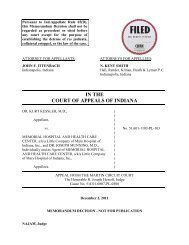Indiana State Health Improvement Plan (I-SHIP) - State of Indiana
Indiana State Health Improvement Plan (I-SHIP) - State of Indiana
Indiana State Health Improvement Plan (I-SHIP) - State of Indiana
You also want an ePaper? Increase the reach of your titles
YUMPU automatically turns print PDFs into web optimized ePapers that Google loves.
Reduce Infant Mortality<br />
Prematurity is the leading cause <strong>of</strong> death among newborn babies. Being<br />
born premature is also a serious health risk for a baby. Some babies will<br />
require special care and spend weeks or months hospitalized in a neonatal<br />
intensive care unit (NICU). Those who survive may face lifelong problems<br />
such as intellectual disabilities, cerebral palsy, breathing and respiratory<br />
problems, vision and hearing loss, and feeding and digestive problems.<br />
In 2008, the March <strong>of</strong> Dimes (MOD) announced that <strong>Indiana</strong> had a failing<br />
grade on its premature birth report card due to a number <strong>of</strong> perinatal<br />
indicators including late preterm births. The consistent escalation <strong>of</strong><br />
<strong>Indiana</strong>‘s preterm rate has created major concerns in the public health<br />
community and prompted a Maternal and Child <strong>Health</strong> (MCH) investigation<br />
into the patterns <strong>of</strong> preterm births and the potential contributing factors.<br />
In September, 2009 MCH released results for the study Trends in Preterm<br />
Birth, Cesarean Delivery, and Induction <strong>of</strong> Labor in <strong>Indiana</strong>: Statistics from<br />
the Live Birth Data, 1990-2006. The purpose <strong>of</strong> this report was to study the<br />
patterns and trends in rates <strong>of</strong> preterm births, cesarean delivery, and<br />
induction <strong>of</strong> labor in <strong>Indiana</strong> between 1990 and 2006 and to explore the<br />
relationship <strong>of</strong> rising preterm rates with cesarean delivery and induction <strong>of</strong><br />
labor.<br />
Over the last two decades, there has been a marked shift in the gestational<br />
age distribution <strong>of</strong> <strong>Indiana</strong> live births towards earlier ages between 1990 and<br />
2006. During this period, very preterm (less than 32 weeks) and moderately<br />
preterm (32-33 weeks) births have increased modestly (by 16 and 15<br />
percent, respectively) whereas late preterm (34-36 weeks) and near term<br />
(37-38 weeks) births have risen sharply (by 38 and 63 percent, respectively).<br />
In contrast, births at 40 weeks or more have noticeably declined.<br />
Cesarean delivery accounted for 29.3% <strong>of</strong> all births in 2006, up by 48%<br />
since the lowest rate <strong>of</strong> 19.8% in 1997. The upward trend in cesarean rates<br />
between 1997 and 2006 was evident across all gestational ages with the<br />
largest increases for late preterm and near term births. Primary cesarean<br />
rates in <strong>Indiana</strong> doubled (1997-2006) even for singleton full term vertex<br />
position births to women with no indicated medical risk factors (birth weight<br />

















